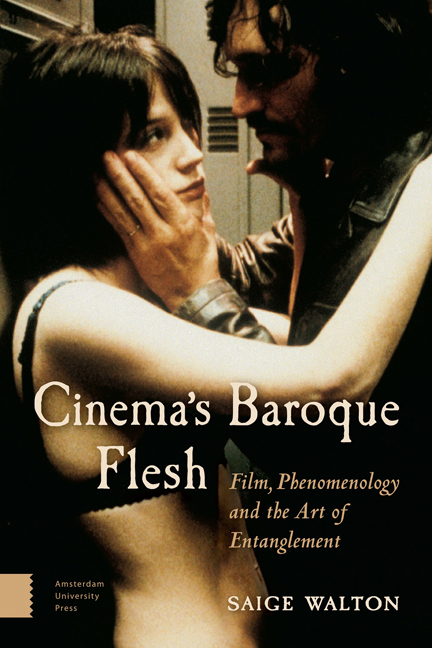Book contents
- Frontmatter
- Dedication
- Contents
- Acknowledgements
- Introduction
- 1 Flesh, Cinema and the Baroque: The Aesthetics of Reversibility
- 2 Knots of Sensation: Co-Extensive Space and a Cinema of the Passions
- 3 Baroque Skin/Semiotics
- 4 One Hand Films the Other: Baroque Haptics
- Conclusion: Or the Baroque ‘Beauty of the Act’
- Notes
- Bibliography
- Filmography
- Index
3 - Baroque Skin/Semiotics
Published online by Cambridge University Press: 12 February 2021
- Frontmatter
- Dedication
- Contents
- Acknowledgements
- Introduction
- 1 Flesh, Cinema and the Baroque: The Aesthetics of Reversibility
- 2 Knots of Sensation: Co-Extensive Space and a Cinema of the Passions
- 3 Baroque Skin/Semiotics
- 4 One Hand Films the Other: Baroque Haptics
- Conclusion: Or the Baroque ‘Beauty of the Act’
- Notes
- Bibliography
- Filmography
- Index
Summary
Language is a skin: I rub my language against the other. It is as if I had words instead of fingers or fingers at the tip of my words […] The emotion derives from a double contact […] I enwrap the other in my words, I caress, brush up against, talk up this contact, I extend myself.
– Roland Barthes (Lover's Discourse, p. 73)[T]he eye in the painterly stage has become sensitive to the most various textures, and it is no contradiction if even here the visual sense seems nourished by the tactile sense—that other tactile sense which relishes the kind of surface, the different skin of things.
– Heinrich Wöllfflin (Principles, p. 27)In this chapter I seek to re-embody semiotics for film studies and for the baroque. This is because the contact that is exchanged between the film's body and the viewer is a source of semiotic as well as sensuous significance in baroque cinema. Rather than perpetuating a split between the word and the world, studies of the skin and properties of signification, I prefer to think of language and experience as always being in chiasm in an encounter with baroque flesh. As Merleau-Ponty tells us, in this ‘baroque world […] although meaning is everywhere figurative, it is meaning which is at issue everywhere’ (‘The Philosopher’, p. 181). Alternatively, we might approach the forms and figurations of the baroque from their reverse, such that ‘[w]hen we say that the perceived thing is grasped “in person” or “in the flesh” […] this is to be taken literally’ (Merleau-Ponty, ‘The Philosopher’, p. 167). Baroque flesh revels in figurative possibilities (the copy or artifice of construction) as well as physical contact to achieve the art of entanglement.
Throughout this chapter, then, we will be returning to the importance of analogy for the baroque and tracing its roots back to seventeenth-century poetics. In this regard, I consider the close connection between ideas of the infinite and the development of baroque poetic language. Given the broad preoccupation with the infinite in seventeenth-century arts, language, science, and philosophy, the historic baroque has often been conceived as a world of shifting, scattered fragments that were unmoored from any grounding ‘centre’. By contrast, I argue that an urge towards connectivity and connection on the part of the baroque spurs the creation of new artfully or artificially constructed wholes.
- Type
- Chapter
- Information
- Cinema's Baroque FleshFilm, Phenomenology and the Art of Entanglement, pp. 127 - 184Publisher: Amsterdam University PressPrint publication year: 2016



